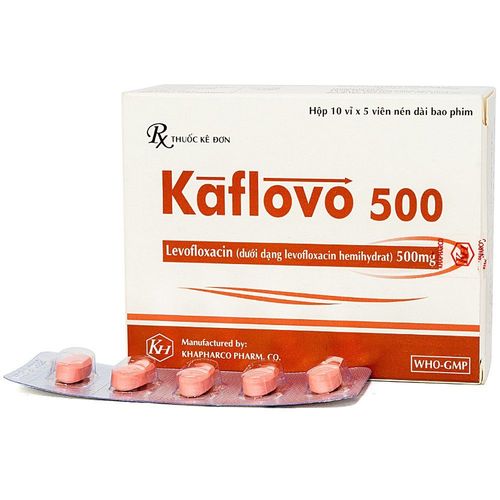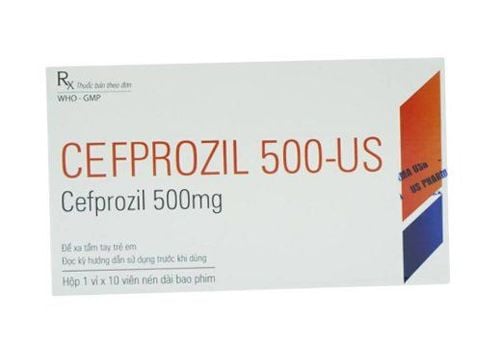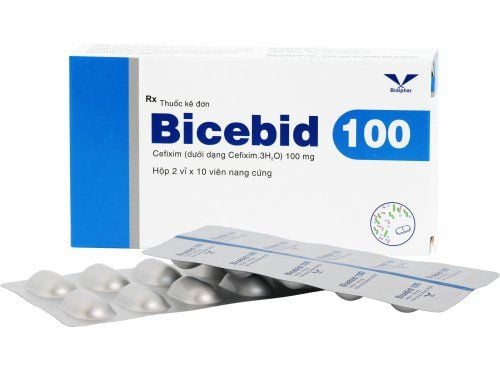This is an automatically translated article.
Cephalosporin antibiotics are widely used in many bacterial infections today. One of the antibiotics in this family is Cefprozil circulating on the market with many trade names, including the product Cefprozil 250 of US Pharma Joint Stock Company. So what is Cefprozil 250mg?
1. What is Cefprozil 250mg?
In vitro, Cefprozil antibiotic has the ability to inhibit many strains of Gram-positive and Gram-negative bacteria through inhibition of bacterial cell wall synthesis. Cefprozil is more stable under the action of beta-lactamase enzymes than another antibiotic of the same class, cefaclor.
Bacterial strains still susceptible to Cefprozil antibiotics include:
Aerobic Gram-positive bacteria: Staphylococcus aureus (including beta-lactamase-producing strains), Streptococcus pneumoniae (Pneumococcal), Streptococcus pyogenes, Enterococcus durans, Enterococcus faecalis, Listeria monocytogenes, Staphylococcus epidermidis (skin staphylococci), Staphylococcus saprophyticus, Staphylococcus wameri, Streptococcus agalactiae, Streptococcus (group C, D, F, and G streptococcus). However, it should be noted that Cefprozil 250 is not effective against Methicillin-resistant Staphylococci and Enterococcus faecium strains, most strains of Acinetobacter, Enterobacter, Morganella morganii, Proteus vulgaris, Providencia, Pseudomonas and Serratia; Gram-negative aerobic: Haemophilus influenzae (including beta-lactamase-producing strains), Moraxella catarrhalis, Citrobacter diversus, Escherichia coli, Klebsiella pneumoniae, Neisseria gonorrhoeae (including beta-lactamase-producing strains), Proteus mirabilis, Salmonella spp., Shigella spp., Vibrio spp; Anaerobic bacteria such as Prevotella melaninogenica, Clostridium difficile, Clostridium perfringens, Fusobacterium spp, Peptostreptococcus spp, Propionibacterium acnes.
2. Indications and contraindications of Cefprozil 250mg
Cefprozil 250mg is indicated for use in the following cases:
Acute otitis media, pharyngitis, tonsillitis; Sinusitis caused by susceptible strains of bacteria such as Streptococcus pneumoniae, Haemophilus influenzae or Moraxella catarrhalis; Bacterial infections secondary to acute bronchitis caused by strains such as Streptococcus pneumoniae, Haemophilus influenzae or M. catarrhalis; Acute exacerbation of chronic bronchitis caused by strains of bacteria sensitive to Cefprozil; Community-acquired pneumonia of mild to moderate severity; Uncomplicated skin/skin tissue infections. However, the drug Cefprozil 250mg is contraindicated for use in cases of hypersensitivity to Cefprozil or other ingredients in the drug, and the possibility of cross-allergy with other Cephalosporin antibiotics should be taken into account.
3. Dosage, how to use Cefprozil 250mg
Cefprozil 250 is produced for oral use with the dose and duration of use prescribed by the treating doctor.
The recommended dosage of Cefprozil 250mg is as follows:
Adults: Acute otitis media: The recommended dose is 500mg (2 Cefprozil 250 tablets) orally every 12 hours for 10 days; Pharyngitis or tonsillitis: The recommended dose is 500mg (2 Cefprozil 250 tablets) orally once daily for 10 days; Acute sinusitis: The recommended dose is 250 mg (1 Cefprozil 250 tablet) orally every 12 hours for 10 days. For moderate to severe infections may be increased to 500mg (2 Cefprozil 250 tablets) orally every 12 hours for 10 days; Secondary bacterial infection after acute bronchitis: It is recommended to take 2 tablets of Cefprozil 250 (equivalent to 500mg of Cefprozil) orally every 12 hours for 10 days; Chronic bronchitis exacerbation: 2 tablets of Cefprozil 250 x 2 taken daily for 10 days; Uncomplicated skin and skin tissue infections: 250-500mg (1-2 Cefprozil 250 tablets) used every 12 hours for 10 days; Dosage of Cefprozil 250 for children: Pharyngitis, tonsillitis: Children over 13 years old take 500 mg (2 Cefprozil 250 tablets) orally once a day for 10 days; Acute sinusitis: Children over 13 years old: 250mg every 12 hours for 10 days, can increase to 500mg if the infection is severe; Secondary bacterial infection after acute bronchitis: Children over 13 years old take 500mg (2 Cefprozil 250 tablets) orally every 12 hours for 10 days; Uncomplicated skin and skin tissue infections: The recommended dose for children over 13 years is 250 to 500 mg orally every 12 hours for 10 days. Dosage of Cefprozil 250 for patients with liver failure: No need to adjust the dose; Dosage of Cefprozil 250 for patients with renal failure does not need to be adjusted if the creatinine clearance is above 30mL/min, in case of less than 30mL/min, only 50% of the usual dose is used; Dosage of Cefprozil 250 for elderly patients: No adjustment is necessary, except in cases of severe hepatic and renal impairment.
4. Side effects of Cefprozil 250mg
Common side effects when using Cefprozil 250mg:
Digestive dysfunction causing diarrhea, nausea, vomiting or abdominal pain; Increased liver enzymes AST (SGOT) and ALT (SGPT); dizziness, hyperactivity, headache, nervousness, insomnia or confusion; Skin rash; Superinfection with strains of bacteria that are not sensitive to Cefprozil; Itching of the genitals, vaginitis. Some rare side effects of Cefprozil 250mg :
Cholestatic jaundice ; Hypersensitivity manifestations such as rash, urticaria; Drowsiness; Decreased white blood cell count or eosinophilia; Increased blood urea and creatinine.
5. Be careful when using Cefprozil 250mg
Colitis and diarrhea associated with Clostridium difficile or due to superinfection with other bacterial strains may occur and promote overgrowth of non-susceptible strains or fungi with prolonged use of Cefprozil 250. Patients should therefore be carefully monitored and treated appropriately if superinfection occurs. Hypersensitivity reactions such as anaphylaxis, erythema, serum sickness-like reactions, and Stevens-Johnson syndrome have been reported with the use of Cefprozil 250 mg. Cross-allergy has been reported between Cephalosporins (such as Cefprozil 250) and other beta-lactam antibiotics, including penicillins and cephamycins. Therefore, before initiating treatment with Cefprozil 250, the physician must thoroughly investigate the patient's allergic history, especially noting the history of allergy to Cephalosporins, penicillins or other drugs. In rare cases, Cefprozil 250mg medicine can cause dizziness, headache, excessive hyperactivity, anxiety, drowsiness, confusion... so it should be used with caution when using for patients to drive and operate. machine. There are no adequate studies on the use of Cefprozil 250 in pregnant patients. Therefore, Cefprozil 250 is indicated for this particular audience only when clearly needed. The antibiotic Cefprozil can be distributed into breast milk, so Cefprozil 250 should be used with caution in nursing patients.
6. Drug interactions of Cefprozil 250
Cefprozil 250 should not be used concurrently with the following drugs:
Aminoglycoside antibiotics can cause increased nephrotoxicity when combined with Cefprozil 250; Probenecid increases the AUC (area under the curve) of the antibiotic cefprozil.
Please dial HOTLINE for more information or register for an appointment HERE. Download MyVinmec app to make appointments faster and to manage your bookings easily.













